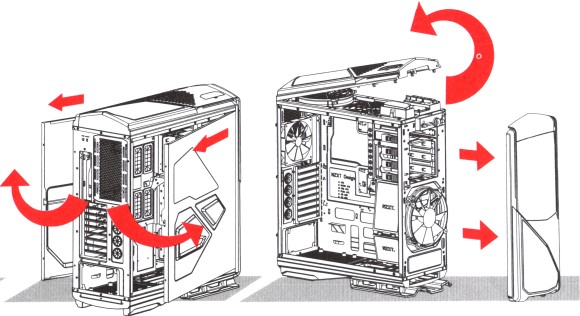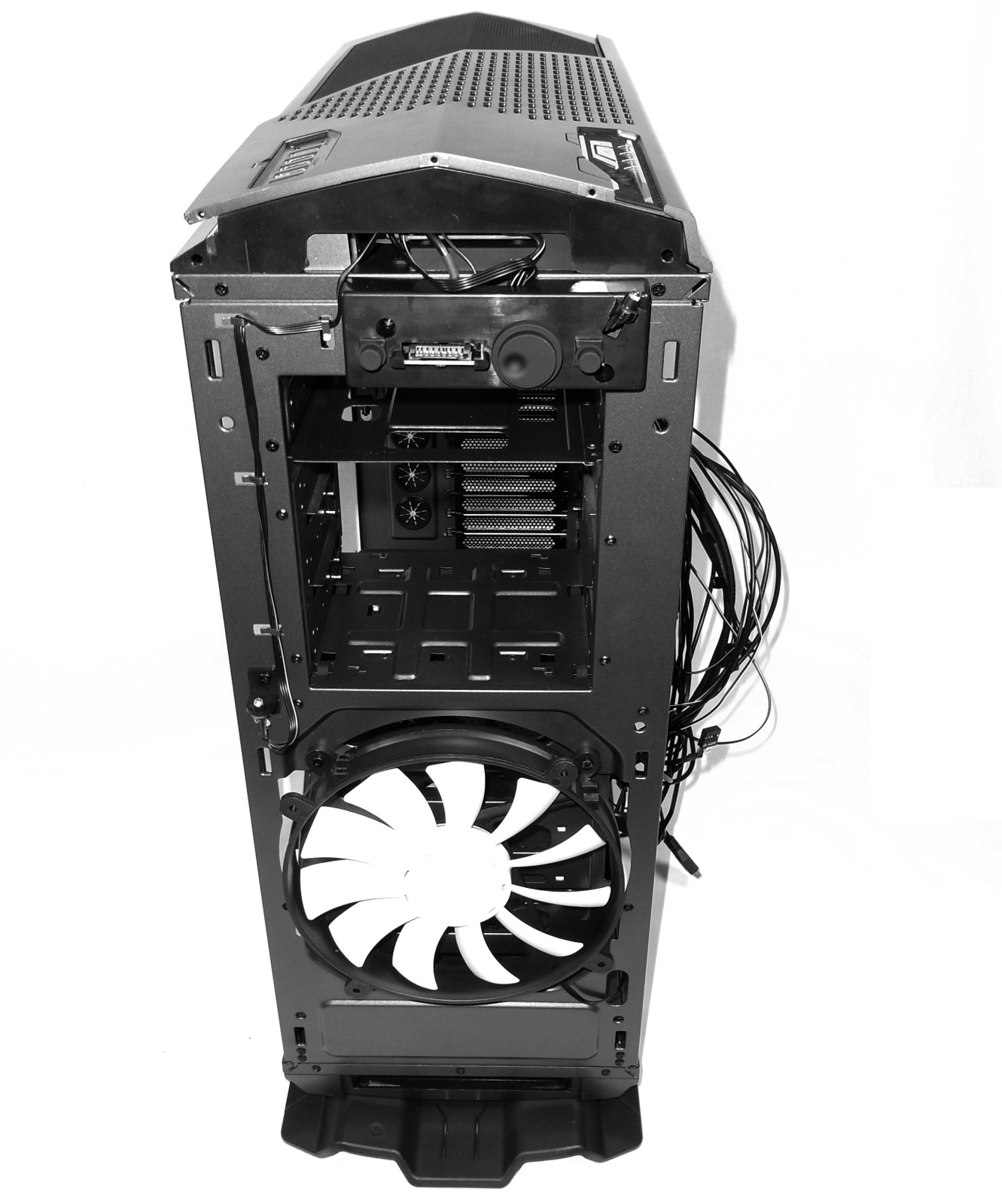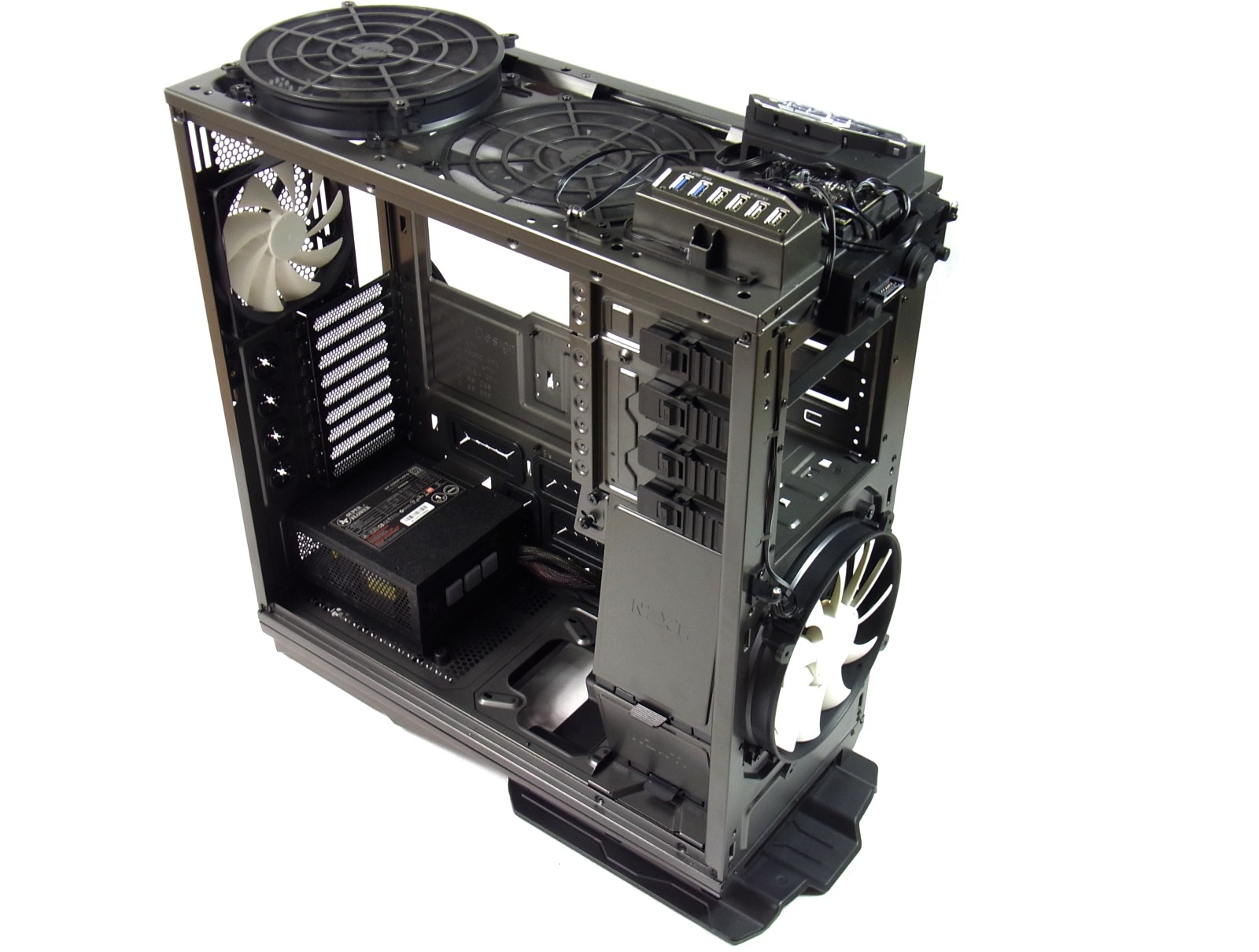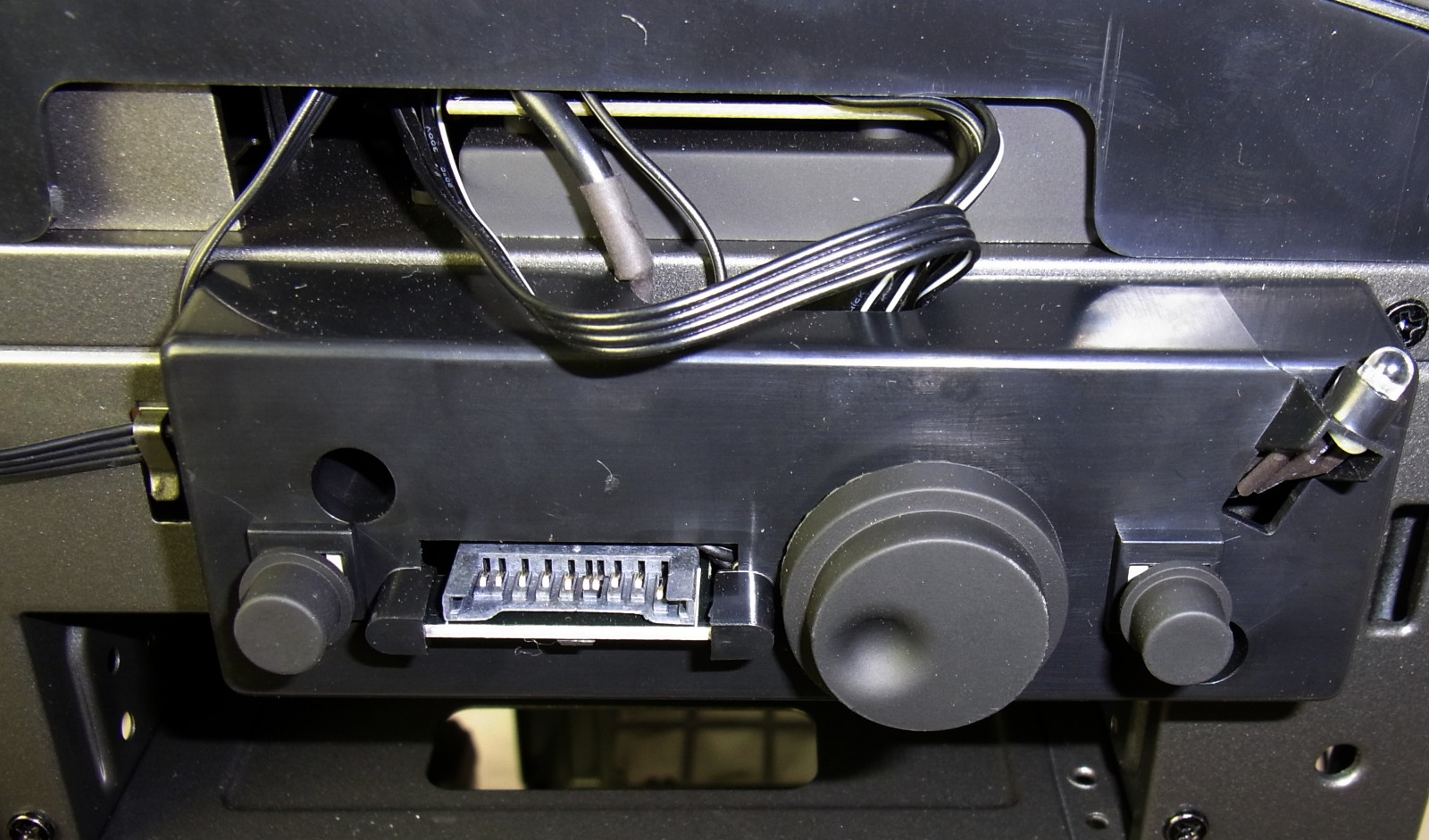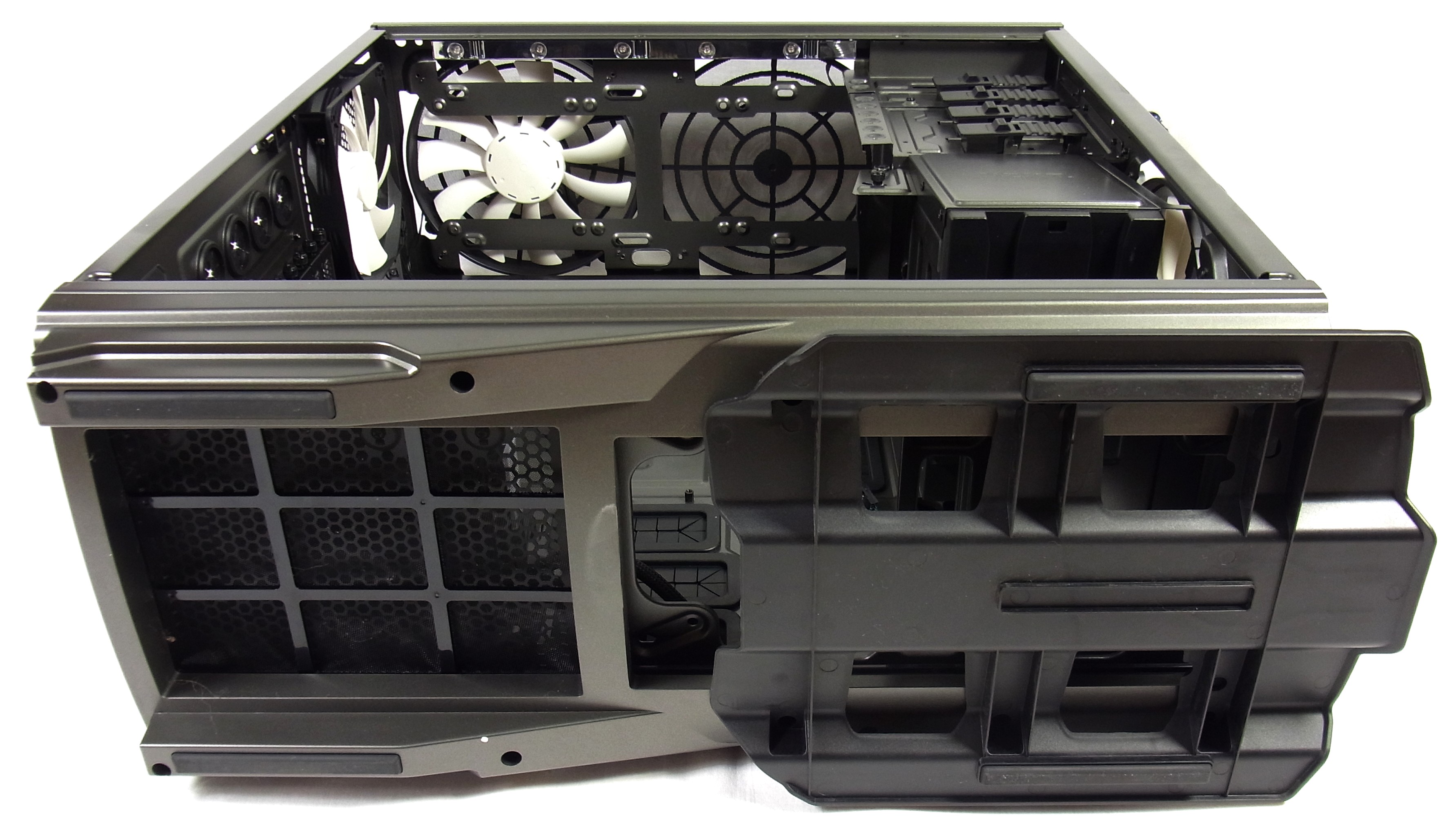NZXT Phantom 820 Case Review: Conceptualized By Enthusiasts
NZXT is extending its portfolio of high-end PC cases with a full-size tower called the Phantom 820. After an extended evaluation, it's clear to us that power users played a big part in defining this enclosure's specs. But the story isn't quite so simple.
Under The Plastic
Taking Off the Plastic
The plastic shroud up front needs to be taken off to install optical drives. This is a pretty easy process. It's held in place firmly by magnets, and you can remove it without worrying about accidentally ripping anything away from the case.
The same goes for the top of the case, which is also easy to remove. This gives you an unobstructed view of the four-channel fan controller and the six USB ports.
The steel frame is more than strong enough to pass our 100 kg load test with flying colors. Even under the strain of the author’s entire body weight, the case just doesn't budge.
The cables run from the small board on top of the case into the enclosure's depths via different routes. It might look a bit messy when you're peeking under the hood, but it works.
The hue control board consists of an RGB color control knob and lighting mode switches. It's conveniently hidden behind the front shroud.
The case stands on four corners, each with a rubber strip glued to it. Although the quartet of surfaces keep the Phantom 820 quite secure, they don't help with acoustics or vibration since the rubber is both thin and hard. Even still, we like everything else about the chassis' frame.
Get Tom's Hardware's best news and in-depth reviews, straight to your inbox.
Current page: Under The Plastic
Prev Page Exterior Finish And Materials Next Page Cooling Design And Fans
Igor Wallossek wrote a wide variety of hardware articles for Tom's Hardware, with a strong focus on technical analysis and in-depth reviews. His contributions have spanned a broad spectrum of PC components, including GPUs, CPUs, workstations, and PC builds. His insightful articles provide readers with detailed knowledge to make informed decisions in the ever-evolving tech landscape
-
ilysaml I like most of the cases out there, but the only major drawback is it's side look, some really like a pure glass window and some other just don't.Reply -
where is comparison(Temp Comparison) with other cases like antec df-85,silverstone raven & nzxt tempest etcReply
-
FormatC It can not be directly compared because each hardware component may deliver different results in different cases. I had once a Silverstone Raven myself - VGA cards with DHE works nice, some other cards with axial fans worse. This can't be an objective comparison.Reply -
cobra5000 Funny, I figured the people who write reviews for pc cases would know a little more about what is going on in the pc case world? The 820 is, CLEARLY, a blending of the NZXT Phantom and the Switch 810. The 810 was the first to pioneer the back panel led, not the 820 like the author notes. I was really, really liking this case on paper. It has the sharp looks of the Phantom and all of the great new features of the 810. The $250 price tag killed that! Also, this review makes it pretty clear that this case is really not on par with other cases in this price bracket. Disappointing, to say the least. At almost $100 less and a better fit and finish, get the 810. $150 less gets you a Phantom in any color of the rainbow. NZXT really got greedy on this one. $250 for sub-par fans and flimsy hard drive cages? I think not!Reply -
FormatC @cobra5000:Reply
The intro (and some other content) of my German orginal is different and refers to the Switch 810 (and Phantom). This was my fault as I proofread the translation. Sorry. -
JonnyDough I'm sorry but when I can get THIS: http://www.newegg.com/Product/Product.aspx?Item=N82E16811139011 for quite a lot less and it has USB 3.0, cable management, an adult look to it, and serves my purpose just fine - I see little reason to spend over three times more on a case that does little more than what this one does.Reply -
army_ant7 Hello again Igor! :)Reply
Nice, thorough review, though I was interested in how you guys do your 100Kg tests! I would've also liked to see you (who I assume was referred to as the author) standing or whatever on the case as was mentioned. :lol:
BTW, I'm not much of a chassis buff, but when I saw the Corsair Obsidian 850D I was amazed at its features. It's been my dream case, but I feel a bit half-hearted about that since I am aware that there are as you said, so many cases out there. I'm not sure if you've ever had your hands on it, but if you have, mind sharing your insights and observations of it, and maybe personally compare it to this or other notable cases. Thanks! :D -
FormatC At first:Reply
I'm waiting for the corsair Obsidian 900D. My own case is an Obsidian 800D and I've modified this case with USB 3.0 and a new SATA3 PCB. It will be interesting, what the new case can better (or not).
About the test:
Simply sit down (without the plastic crap on top) and try to sit on it one minute. After this I've used my water venture... I'm a typical 100 kg heavy-weight reviewer and this is really enough to destroy something (some cases were mess after this). -
ckholt83 I hate the stupid looking plastic foot at the front of the case, it looks like a tacked on afterthought.Reply -
army_ant7 Reply
If that's the case, I'll be looking forward to a review of it (900D)! Also yeah, side notes by you on how it does compared to older models. :D9539960 said:At first:
I'm waiting for the corsair Obsidian 900D. My own case is an Obsidian 800D and I've modified this case with USB 3.0 and a new SATA3 PCB. It will be interesting, what the new case can better (or not).
About the test:
Simply sit down (without the plastic crap on top) and try to sit on it one minute. After this I've used my water venture... I'm a typical 100 kg heavy-weight reviewer and this is really enough to destroy something (some cases were mess after this).
Oh, so the two tests are one and the same. Hehe... I see... I hope you haven't gotten into any accidents by doing that with any cases. Ripped up pieces of metal can be nasty...
In your opinion, are Corsair Obsidians (or at least the one you have) the best you've seen? (I value your opinion because I bet you've gone through a lot of cases, or at least reviews of them.) :)
